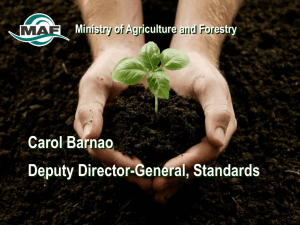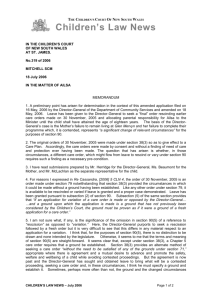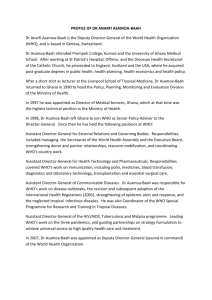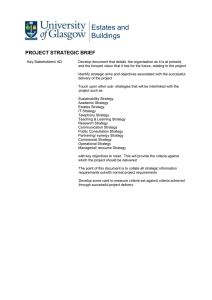Animal Products Amendment Bill
advertisement
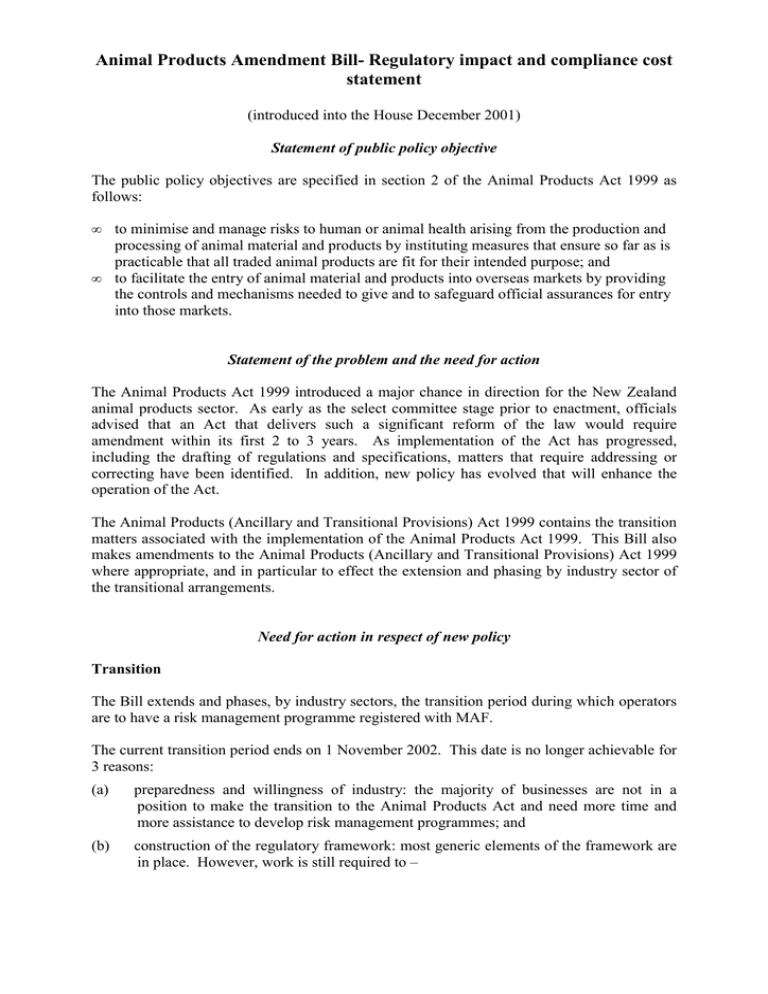
Animal Products Amendment Bill- Regulatory impact and compliance cost statement (introduced into the House December 2001) Statement of public policy objective The public policy objectives are specified in section 2 of the Animal Products Act 1999 as follows: • • to minimise and manage risks to human or animal health arising from the production and processing of animal material and products by instituting measures that ensure so far as is practicable that all traded animal products are fit for their intended purpose; and to facilitate the entry of animal material and products into overseas markets by providing the controls and mechanisms needed to give and to safeguard official assurances for entry into those markets. Statement of the problem and the need for action The Animal Products Act 1999 introduced a major chance in direction for the New Zealand animal products sector. As early as the select committee stage prior to enactment, officials advised that an Act that delivers such a significant reform of the law would require amendment within its first 2 to 3 years. As implementation of the Act has progressed, including the drafting of regulations and specifications, matters that require addressing or correcting have been identified. In addition, new policy has evolved that will enhance the operation of the Act. The Animal Products (Ancillary and Transitional Provisions) Act 1999 contains the transition matters associated with the implementation of the Animal Products Act 1999. This Bill also makes amendments to the Animal Products (Ancillary and Transitional Provisions) Act 1999 where appropriate, and in particular to effect the extension and phasing by industry sector of the transitional arrangements. Need for action in respect of new policy Transition The Bill extends and phases, by industry sectors, the transition period during which operators are to have a risk management programme registered with MAF. The current transition period ends on 1 November 2002. This date is no longer achievable for 3 reasons: (a) preparedness and willingness of industry: the majority of businesses are not in a position to make the transition to the Animal Products Act and need more time and more assistance to develop risk management programmes; and (b) construction of the regulatory framework: most generic elements of the framework are in place. However, work is still required to – (i) complete the review and re-drafting of technical requirements currently under the Meat Act into a form appropriate for the Animal Products Act; and (ii) complete the appropriate regulatory framework for those animal species, operators and processors that were either not covered under the Meat Act regime, or were not covered in a way that facilitates transition into the Animal Products Act regime; and (c) availability of skilled persons (evaluators, verifiers, consultants): currently, New Zealand does not have a sufficient pool of technical people who can assist industry in developing and implementing risk management programmes by November 2002. This includes access to consultants to help design risk management programmes, and evaluators to evaluate risk management programmes prior to registration. Homekill The Bill prohibits persons from operating "select and slaughter" activities as a commercial operation, and defines the phrase "actively engaged in day-to-day maintenance" for the purpose of clarifying who may make use of a homekill and recreational catch service provider. The development of a "select and slaughter" trade and consequent increase in the availability of unregulated meat could undermine the policy intent of Part 6 of the Act, and could impact on public health and New Zealand's trading status. Homekill waste The Bill provides for the trade of homekill material to rendering operations, subject to the Director-General having the power to impose conditions. The current provisions of the Act preclude the sale of waste materials, such as offal and trimmings, to renderers. This is not the intended policy and is an unjustifiable constraint on commerce. Maintaining such a restriction could well have detrimental safety and environmental effects if "waste" material cannot be conveniently disposed of. Director-General directions The Bill provides a new mechanism to ensure that directions given by the Director-General to non-MAF employed personnel are delivered and followed. The Bill provides for the realities of passing directions and instructions to non-State Sector employed statutory officers. In practice communications of this nature may be passed to individual officers or to the employer of the officer, or officers, concerned. The Bill recognises this and places obligations on the givers and receivers of such communications to ensure that all relevant parties are made aware of the communications within a reasonable time. The term "reasonable time" is defined. Powers of officers The Bill expands the powers of officers to enter premises and their powers to reclassify animal product. Currently, an officer may only enter premises where animal materials or products that are not intended for human consumption are processed if those premises are subject to a risk management programme or a regulated control scheme. An officer, however, will have legitimate interest in some places or premises where animal material or products are handled although they are not covered by a risk management programme or regulated control scheme (e.g., to undertake a compliance cheek or to further an investigation of a particular incident). Under the current provisions the officer could only enter with a search warrant. This is unnecessarily restrictive, requires the involvement of judicial personnel, and imposes a requirement related more closely to the committing of an offence than is necessary or desirable. Section 90 enables an animal product officer, on forming an opinion regarding the fitness for intended purpose of animal product, to take certain actions including ordering the destruction, disposal, or rectification of the relevant material or product. However, the section does not currently permit the officer to reclassify the use for which the material or product may be used. This is an oversight that is being remedied in this Bill. Assistance for officers The Bill makes provision for a person called on to assist an officer to enter the premises or place where their assistance is required. Section 88(3), which relates to the power to examine, inquire, etc, provides the authority for an officer to "call on any person to assist him or her in the exercise of his or her powers under this section". It is not clear, however, that the person called on to assist has the authority to enter any place or premises, etc, that the officer has. This has the potential to restrict an officer to calling only on those persons already on the premises when he or she enters, where in fact an officer may require the assistance of other persons (e.g., technical experts). Offence for non-compliant material A new offence provision is provided which is related to the presentation of non-complying animal material for processing. Section 129 makes it an offence to present for sale for processing for human or animal consumption (whether directly or by an agent) any animal material that fails to comply with any requirements of Parts 2 to 4 that apply. This does not cover the situation where, as is often the case, the processor already owns the animal material at the time of presentation for processing. In such a case there is no sale. The new offence provision covers this situation. Official assurances for mixed ingredient products The Bill provides for the removal of a possible obstacle to the granting of official assurances to animal products that may also be dairy produce under the Dairy Industry Act 1952, e.g., mixed or multi-ingredient products. Section 8(b) currently provides that all dairy produce, within the meaning of the Dairy Industry Act 1952, is excluded from the ambit of the Animal Products Act. The amendment makes it clear that official assurances may be issued in respect of products that include dairy produce in their make-up. Risk management programme outline Provision is made for the Director-General to accept an outline of a risk management programme for registration under certain circumstances. The current wording in the Act presents a logistical problem in that the risk management programmes for a complex operation may run to many volumes of material. Whereas the evaluator and the verifier involved need to have every detail of the risk management programme available, it is sufficient for the Director-General to receive a summary. Clarification of accountabilities in respect of actions and omissions by non-State Sector inspectors The Bill provides for the clarification of accountabilities in respect of non-State Sector inspectors performing inspector functions during the transition period. Persons "treated as or deemed to be inspectors" under the provisions of Animal Products (Ancillary and Transitional Provisions) Act will include employees of State-owned enterprises, but also includes employees of businesses in the private sector. When all businesses are subject to the Animal Products Act (at the completion of the transition) some of the tasks currently performed by inspectors will be performed by the operator of the business. During the transition period some of these tasks are able to be performed by inspectors. The amendment applies to clarify that the employing bodies of non-State Sector inspectors are to be accountable for the negligent actions or omissions of these inspectors. The effect of the clause is back-dated to the coming into effect of the Animal Products Act, subject to any proceedings commenced prior to introduction of the Bill. This is because proceedings may be brought at any time within 6 years of the action or omission occurring. Movement and related controls The Bill includes a specific provision to enable the Director-General to impose a range of risk management measures to eliminate or manage risks resulting from contamination of animal material. The provision allows for the control and management of animal movement including the actual transportation of animals. Random sampling or other information may result in the identification of a potential or suspected source of contamination of animal material or product. Examples include chemicals in land (e.g., DDT), or an environmental event (e.g., volcanic eruption) with resultant contamination of surrounding farmland and livestock. The Bill enables a range of risk management measures to be applied so that the risk source or the affected animal material can be controlled or managed. The measures include the ability to address the risk source itself or the affected animal material so that either the risk of actual contamination occurring is prevented or minimised, or potentially affected animal material is appropriately handled. Listing certain game estates The Bill inserts a new Part into the Act that provides for certain game estates to be listed and comply with various requirements. Animals hunted on game estates have historically fallen into a grey area of the law as they are not categorised either as farmed animals or wild animals. Game estate animals may be used or consumed by the client hunter, or a game estate operator may desire to have culled animals (or those not wanted by a client hunter) processed through the regulated system. To prevent the development of "select and slaughter" type operations and ensure that unregulated meat is not traded, while allowing clients to consume their own catch, and game estate material to enter the regulated trade, the Bill requires certain game estates to be listed with MAF and for certain requirements to apply. The terms "game estate" and "client hunter" are defined within the Bill. Statement of options for achieving the desired objective Based on advice from Parliamentary Counsel Office and MAF Legal Services, the matters that could be addressed through regulations or specification or by administrative mechanisms have been done. The amendments proposed in this Bill are those that can only be addressed by amendment to the Act. The end of the current transition period is specified in the Animal Products (Ancillary and Transitional Provisions) Act 1999 and can therefore only be changed by amendment to that Act. Statement of the net benefit The Animal Products Act delivers significant reforms for the sectors affected and these reforms will not be complete without the changes proposed in this amendment. Specific net benefits for new policy proposals Transition All existing businesses will have some additional time to comply with the requirement to have a risk management programme in place. This will range from an additional 8 months for those required to move by 1 July 2003, to an additional 3 years 8 months for those required to move by 1 July 2006. For those sector groups required to move by July 2003 and July 2004, the transition time will align more closely with the 3-year transition period that the Act originally proposed. It also provides for a controlled movement of industry groups or sub-groups, allowing resources within industry, third party providers, and MAF to cope with the workload. Some costs associated with maintaining the Meat Act regime will continue. However, the existing transition period is not achievable. Extending the transition will also spread costs to industry of developing risk management programmes and will allow more time for the market to establish the necessary services associated with risk management programme development, evaluation, and verification. Homekill Clear boundaries as to what is acceptable homekill activity are necessary to ensure the integrity of the risk management system to meet the public policy objectives of protecting public health and facilitating access to markets for regulated animal products. Potentially, there are costs to individual operators, particularly those that will have to cease providing a “select and slaughter” service. On the other hand, New Zealand's homekill treatment can be considered liberal in contrast to some of our trading partners. Any expansion or loss of confidence in our ability to control the potential circulation of unregulated meat could result in significant markets such as the European Union and the United States imposing trade sanctions against New Zealand. An elimination of potential “select and slaughter” activity also eliminates the potential flow-on problems, e.g., disposal of waste and animal welfare concerns if inexperienced people are slaughtering animals. Homekill waste The Act allows for homekill waste only to be "gifted" to renderers and not traded. This was an unintended impact and restricts a significant market in New Zealand. The amendment will allow for the convenient disposal of "waste" material to renderers whose risk management programmes will deal with the relevant risks associated with such material, thus ensuring human and animal health is protected. New policies related to the powers of the Director-General, the powers of officers, and the new offence provision Adequate compliance monitoring activity is critical to ensure standards and overseas market access requirements are met. Inadequate powers could result in widespread non-compliance events and there may be trade sanctions against New Zealand if our trading partners lose confidence in our ability to ensure compliance. These proposals will ensure the integrity of the risk management system in meeting the public policy objectives of protecting public health and facilitating access to markets for regulated animal products. Also, the proposals will ensure that officers are able to use their powers to determine compliance with the Act at reasonable times. Finally, the proposals will clarify the law. Official assurances for mixed ingredient products Those animal products, within the meaning of the Animal Products Act, that also fall within the definition of "dairy produce under the Dairy Industry Act will be able to apply for official assurances under the Animal Products Act. Industry compliance costs will be reduced if they only have to deal with 1 administrator. Risk management programme outline Those animal product businesses that have large or complex risk management programmes will have reduced costs, as they will not have to supply the Director-General with copies of documents that could be very extensive. Clarification of accountabilities in respect of actions and omissions by non-State sector inspectors The Crown will not be financially liable for the actions of persons not under its direct control. Movement and related controls The ability to deal with risks of contamination at source is an essential element of a comprehensive risk management system. Preventing such material from entering primary processing, or limiting the end products for which it may be used, ensures that fitness for intended purpose can be assured and the objectives of the Act can be met. Tracing back non-complying animal material to the risk source is critical in dealing with product that may be infected by foot and mouth, bovine spongiform encephalopathy, or chemical contaminates. At present, New Zealand has no sound legal basis to trace inter-farm stock movement, which is necessary to ensure New Zealand has the means to effectively respond to and manage adverse events. Listing certain game estates The proposal applies only to those game estates that want to supply animal material for primary processing (currently culled animals or carcasses minus the trophy head must be dumped); or to those whose client hunters want to take their animal for their own consumption. The game estate operators directly benefit from the proposal. They will be able to trade the animals into the regulated system when the conditions set by the Director-General are met. The listing of game estates will provide for the identification of genuine game estate operations and help ensure the separation of regulated and unregulated animal material. Business compliance cost statement The potential costs associated with the requirement to develop and operate under a risk management programme were considered during the passage of the original Animal Products Act in 1999. The proposal to extend and phase the transition does not affect the original analysis; it only provides for a longer time-frame over which the costs may be spread for some operators. Those new policy proposals that may involve an increase in business compliance costs over and above those costs associated with the requirements of the Animal Products Act 1999 and the Animal Products (Ancillary and Transitional Provisions) Act 1999 as currently drafted are as follows. Homekill This proposal gives a definition of the term actively engaged in day-to-day maintenance and should assist service providers. MAF currently provides a declaration statement that homekill services providers can use (on a voluntary basis) in cases where they are dealing with clients not previously known to them. It is suggested that such a declaration form would continue to be useful to services providers. Director-General directions Those businesses that employ personnel who have statutory functions and duties under the Act will need to ensure that they have systems in place so that directions, notices, and other requirements of the Director-General are known to their staff. This will affect businesses that become recognised agencies under the Act. However, the maintenance of effective communications channels between employer and employee is a feature of modem businesses, and maintenance of such systems to ensure relevant staff can carry out the statutory functions they may have under the Act is a reasonable expectation. Official assurances for mixed ingredient products For those businesses dealing with such products the compliance costs associated with gaining an official assurance under the Animal Products Act should be reduced. Risk management programme outline Those businesses applying for registration of a large risk management programme will be able to make application in a summarised form thus reducing the potential compliance costs associated with having to provide the Director-General with a copy of a risk management programme that may run to several volumes. Movement and related controls The choice of risk management measures to be applied depends on the seriousness and probability of harm occurring in the absence of adequate preventive actions. Recognising the potential for compliance costs, and ultimately the restrictive and coercive nature of some of the risk management measures that may be required to deal with a particular circumstance, the Act is the appropriate place for such a legislative power rather than at the level of regulations. The Bill specifies the matters that the Director-General must consider before applying any specific measure. It is also noted that a similar power is currently in the Meat Act 1981. Listing certain game estates There are costs associated with listing, including a listing fee which is expected to be annual and costs associated with keeping of records to allow for trace back of animal material. These will be more than offset by the ability to utilise meat from culled animals or animal carcasses not wanted by the client hunter (many clients only want the trophy head not the meat) and trading these into the regulated system when certain conditions are met. The requirement to be listed only applies to those game estates that choose to benefit from the ability to supply animals to the regulated system, and thus utilising this provision becomes a commercial decision for the game estate operator. Consultation The Ministry of Health, Ministry of Economic Development, the Treasury, Ministry of Justice, and the Department of Prime Minister and Cabinet were consulted in the preparation of the policy papers related to the proposals in this Bill. The proposals related to homekill have been shared with Federated Farmers, the Rural Butchers Association, and the Retail Meats and Allied Trades Association. The Rural Butchers Association and the Retail Meats and Allied Trades Association support the general thrust of these proposals and have made helpful suggestions as to their future implementation. These proposals were also discussed with the Primary Production Select Committee, Primary Production Caucus Committee, the Alliance Consultation Minister, and the Greens in June 2000. MAF has previously circulated a proposal related to movement controls: MAF Public Discussion Paper No 20: Proposed Contamination Monitoring and Surveillance Regulated Control Scheme which was distributed in July 2000. The paper contained a specific proposal for the making of regulations that would allow the Director-General to impose a range of risk management measures similar to those now proposed for inclusion in an amendment to the Animal Products Act. A number of submissions were received on the discussion paper, no submission raised any objection to the proposals related to the risk management measures. MAF officials undertook a limited and targeted consultation with representatives of the various industry groups likely to be affected by the proposal to extend and phase the transition period. This was done through the CEO and/or chairperson of various industry associations and followed up with discussions with members of the industry standard councils when requested. Since then, there has been wider open discussion in industry on the extension to the transition. There is a wide and general support for these proposals. However, there were some suggestions that a delayed transition should not be made, or that all operators of a particular kind should move to the new regime at the same time. For reasons of practicality, and to smooth the workflow for risk management programme evaluations, the splitting of some groups is recommended but in one case (poultry processors), it was agreed with industry that one transition date was best. As the consultation was targeted to representative organisations, it can be expected that some individual operators may seek to be in a later grouping. MAF officials undertook a limited and targeted consultation with representatives from the Game Estate Association on the proposal to list certain game estates.
